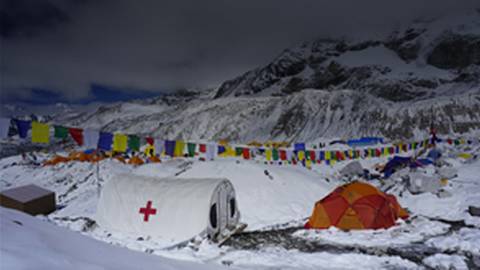Everest ER: Practicing Medicine at 17,000 Feet
Imagine practicing medicine at an altitude of 17,000 feet, with Mount Everest standing right outside your front door. What kinds of challenges would you face on a daily basis? Managing altitude sicknesses, for sure, but what about the constant threat of all your IV fluids freezing? Or proving day in and day out why duct tape may just be the most essential, all-purpose medical tool ever created?
That’s just the tip of the proverbial iceberg—or mountain in this case—for Dr. Luanne Freer, the Founder and Director of Everest ER.
Profession, Passion, Philanthropy
Those are the three things that drive Dr. Freer, who’s no stranger to caring for patients in challenging environments. From practicing emergency medicine at Yellowstone National Park to combating the Ebola outbreak in Sierra Leone, Dr. Freer’s desire to find opportunities that combine the practice of medicine with her passion for the wilderness and that enable her to help those in need has taken her all over the world—including to one of the highest elevation regions on Earth.
After traveling to Nepal as a volunteer for the Himalayan Rescue Association, Dr. Freer was shocked to learn that the few physicians on Mt. Everest were either climbers themselves or were contracted by a specific team to only care for its members. Just as surprising was the fact that some of them had very little training in mountain medicine.
That’s when she knew there was a need for experienced, well-trained physicians to care for both climbers and their Sherpa mountain guides, and so in 1999, Everest ER was born.
Medicine in the Mountains
Even after completing training courses and treating altitude illnesses at Yellowstone National Park’s moderate elevation, Dr. Freer admits that nothing really could’ve prepared her for Mt. Everest’s harsh—and oftentimes unpredictable—conditions.
Keeping the formulary of medicine above water when the glacier melts on warm days, powering equipment, thawing frozen IV fluids, and translating a medicine’s label are just some of the challenges Dr. Freer has encountered, which is why the ability to improvise is a must for any member of the Everest ER team.
But Dr. Freer assured us it’s not all bleak on the mountainside. While it’s certainly challenging, there’s also a level of freedom that comes with it. Since there’s no access to CT scans or laboratory tests, physicians are required to rely on their clinical skills and listen to the patient’s heart and breath sounds themselves; in a way, it’s the practice of medicine in its purest form.
Another benefit is that there’s very little record keeping on Mt. Everest, so volunteer physicians are quite often surprised—and thrilled—to learn that there’s no complicated coding or contracting with businesses and insurance companies.
Fulfilling a Life-Saving Mission
Regardless of the pros and cons, saving lives is at the heart of Everest ER’s mission, and one story from their very first year on the mountain still sticks out in Dr. Freer’s mind.
One night, a “drunk” Sherpa was carried into Everest ER’s tent to see if they could help sober him up. But what this Sherpa’s team thought was intoxication was actually high-altitude cerebral edema, which can cause ataxia, or a stumbling, drunken-looking gait.
Recognizing this life-threatening condition, Dr. Freer immediately gave this Sherpa oxygen, a high-powered steroid, and put him into a portable hyperbaric chamber, which simulates a descent; in this case, that descent was from 17,600 feet to about 10,000 feet.
Within 15 minutes, he regained consciousness, and so they were able to continue treatment and save his life.
To Dr. Freer, this one case reaffirmed Everest ER’s mission, which has now been saving lives on the mountain for more than 20 years.
The Evolution of Everest ER
Since Everest ER was founded more than 20 years ago, it should come as no surprise that Dr. Freer has seen a lot of changes over the years. For instance, there weren’t any helicopters that could safely land in Base Camp back in 1999, but now, there’s close to 10 helicopters that can not only land in Base Camp, but can fly to much higher camps and get patients to care faster.
Beyond the technological advances, another positive change is that more and more Nepali physicians are volunteering for the Everest ER team. It was Dr. Freer’s dream from the very beginning to turn Everest ER over to the Napalis one day, and so she hopes to see that trend continue.
But perhaps the biggest change is that most of the operations have transitioned to a Nepali NGO directorship. While Dr. Freer still continues to choose and orient physicians who volunteer for Everest ER, this transition has enabled her to find other opportunities that combine those three things that mean the most to her: profession, passion, and philanthropy.
To learn more about Everest ER, visit EverestER.org.


Facebook Comments